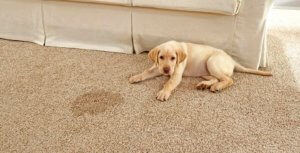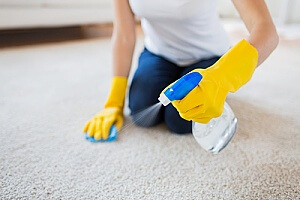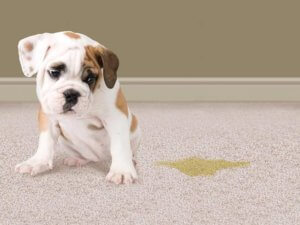Your carpet is probably reeking of dog and cat urine by now. So, I won’t dilly-dally with how to get the dirt and odor off.
Let’s get to business.
In this article, you’ll learn:
- The tools needed to get pets pee off your carpet
- The exact steps to follow to remove the pet pee stains and odor, even as a beginner
Getting Started: What Do You Need?
Cleaning Tools
- A bowl or bucket
- A brush, preferably soft-bristled
- A spray bottle
- Cleaners – 5 options to be discussed
- Disposable rubber gloves
- Flashlight
- Paper towels
- Vacuum
- Water
What Cleaner Should You Use?
Frankly, there is no one best cleaner to get dog & cat urine off your carpet. The right one to use depends on a few factors.
- Is the urine new or dried?
- Is it dog or cat urine?
- What is the material of your carpet: soft or hard?
Your answer to the questions above will ultimately determine the cleaner to use.
Nevertheless, here is a quick run-down of the 5 cleaners:
- Enzymatic cleaners — are perfect for removing dried pee, especially cats’. Unfortunately, these cleaners are not the best stain removers.
From experience, they are more like odor eliminators. As a result, they often only remove the odor-causing element in the pee/feces (urea) and leave out other ingredients that might form a sticky residue on your carpet.
- Vinegar and baking soda mix — is eco-friendly. Like enzyme cleaners, this mix absorbs odor — thanks to the vinegar component. Also, it neutralizes the bacteria in the urine.
The baking soda component is responsible for removing stains.
- Fresh hydrogen peroxide from a drugstore — is the best stain remover for deep and dried stains. However, it has bleaching effects. So, test it on dark-colored or nylon-material carpets in an open space first.
- Dish Detergent — by itself, isn’t an effective pee remover. Combine with hydrogen peroxide for the most results.
- Laundry Detergent — is only a quick fix for fresh pee. And be cautious while at it. Otherwise, you will sog your carpet.
Whatever cleaner you use (even the so-called pet-friendly types), always keep your pet out of the room while cleaning.
Now, the ingredients are ready. Let’s remove dog & cat pee stains (and odors) from your carpets.

Removing Fresh and Dried Dog & Cat Urine Out of Carpet in 5 Steps
Heads up: I’ll split this section into two (for fresh and dried pee) for easy comprehension.
Removing Fresh Pee
Step 1: Clean the fresh pee
You’re lucky if you catch a fresh pee. Clean it right there.
So, how do you go about the cleaning?
Get your protective rubber gloves. You can use your bare hands too. But I often don’t recommend it. You might be allergic to dog or cat pee.
About cleaning the pee, the patch will be visible. Good.
Now, grab a pair of paper towels. Alternatively, you can use old towels. But they are not as effective.
Start cleaning.
While you’re at it, don’t rub the fresh pee. Doing so will only worsen the stain and push it deeper into your carpet.
Instead, blot the carpet. Let the paper towel soak up as much pee as possible.
Pro tip: stand on the paper towel to fasten the soaking process.
Step 2: Deodorize
Whether fresh or dried, cat and dog pee smells like hell. And paper towels can only absorb a bit of all that odor.
So, you need to apply a deodorizer.
Fortunately, some cleaners can also double as deodorizers. In this case, we’ll use a vinegar and water mix.
So, how should you go about the mix?
- Get your bucket
- Add water to white vinegar in a 1:1 mix
- Pour the mixture into a spray bottle
- Apply the mix to the affected area
- Let the mix sit for up to 5-10 minutes
While waiting for the mix to soak, play with your pet. But reinforce your potty training. Otherwise, you might have yet another fresh pee to deal with.
Step 3: Apply the cleaning mixture
Once the 10-minute waiting time is up, sprinkle baking soda (the cleaning agent) on the white vinegar and water mix.
Be generous while applying baking soda. It must completely cover the mix. Also, it should be thick — about one-fourth.
Next, get your soft-bristled brush. Use it to work the baking soda into the carpet. Again, remember not to rub.
Cover the areas with a paper towel and leave the mixture to work. However, the waiting time can be tricky.
- You can leave the mix for 24 hours. This is often the best way to let the mixture take effect.
- 8 hours of waiting also work, or
- Leave the mix on affected area only for 15 minutes
Then, clean…

Step 4: Dry the carpet
Whether 8 or 24 hours or 15 minutes, apply yet another paper towel to soak up the moisture. Now, get your vacuum.
Use the vacuum (preferably a wet-dry vacuum) to dry up the affected area.
Note: vacuuming, while effective, is not enough. Your carpet needs natural air drying. So, expose the affected area to direct sunlight.
That should do the trick.
Step 5: Assessment
Once the moisture is dried up, check the stain. Is it off your carpet?
How about the odor?
If no, repeat steps 1 – 4. This time, use a more powerful deodorizer (enzymatic cleaners) and cleaner ( hydrogen peroxide).
Also, check the floor. The chances are that the pee goes deeper than you thought.
So, check and confirm you applied the correct depth of cleaner.
Removing Dried Pee
Step 1: Locate the dried pee
Dried pee smells worse, especially from male cats marking territories. But that doesn’t mean you’ll know the exact source.
And unfortunately, there are no wet patches to help out. So, what can you do?
- Get a flashlight/black light, preferably an ultraviolet-light-enabled aid with 9-12 bulbs.
- Turn off your lights, or make the room dark.
- Now, flash the black light around the suspected areas on your carpet. Start from the out-of-light corners.
- Look out for glows. Those are the dried urine polluting your room.
Alternatively, you can install hidden cameras to monitor the movement of your pets. But you will spend significant time watching videos that might not even reveal what you seek.
Besides, cameras are expensive. Black lights, on the other hand, are affordable. They will only cost you $15 max — and moving around the house to locate glows.

Step 2: Deodorize
Vinegar might work a bit to deodorize dried pee. But frankly, I wouldn’t recommend it.
Instead, go all out for enzymatic cleaners.
But note this:
For enzymatic cleaners to remove odors, you must apply them generously. No sprinkling or spraying.
You’ll pour the cleaner on the dried pee until it’s soaked.
While at it, avoid enzymatic cleaners that promise to deliver stain and odor remover functions. They are likely lying because both are chemically incompatible.
Stick to the odor-eliminating function.
As mentioned earlier, enzymatic cleaners will only remove the urea part of the pee. In other words, there will be a sticky residue.
This is where you need the cleaning agent.
Note: adding cleaning agents directly to enzymatic cleaners will limit their effects. So, use water to rinse the latter off first.
Step 3: Apply the cleaning mixture
Baking soda or laundry detergent won’t deliver the right cleaning aid for dried pee. What you need is hydrogen peroxide.
Note: ensure you buy the correct hydrogen peroxide. Use this simple guide:
- Get the cleaning liquid from a drugstore
- Do a simple test; listen for a fizzing sound when you open the container.
- If there is no dizzying sound, don’t use the liquid. It’s not hydrogen peroxide.
Say you eventually got the authentic hydrogen peroxide. How about the bleaching effects?
Dilute the solution with dish detergent. Here is how:
- Add half a cup of hydrogen peroxide to your spraying bottle
- Add ¼ dish detergent to the solution
- Add 2 cups of water to the mix
Now, spray the dried pee with the diluted hydrogen peroxide solution.
Next, soak the solution into the affected area with your soft-bristled brush in a circular movement. Don’t rub or scrub.
Now, wait for 5 minutes. Apply a handful of baking soda to the affected area. Let it cover the entire stain.
Cover the mix with a paper towel. Then, wait for another 15 minutes.
Step 4: Dry the carpet
Thankfully, you don’t need to wait up to a day to dry your carpet, unlike with fresh pee. Within 30 minutes, you can start drying the affected area.
Like fresh pee cleaning, you also need a combination of vacuum-drying and air-drying. Doing so will give your carpet a refreshed and natural look and smell.
Step 5: Assessment
Now, check the odor. Is it still there?
What about stains? Is there any grime-like dirt in the cleaned area?
If the odor persists, you need to repeat the earlier steps. Repeat until the carpet is 100% clean and not foul-smelling.
Voila!
Your carpet is now free of dog & cat pee — the stains and odors. But the removal methods seem long, huh?
Are there faster ways to get results?
What Is the Fastest Way to Get Dog & Cat Urine Out of Your Carpet?

Short answer: prevent your dog & cat from peeing on your carpet in the first place.
That is probably easier said than done. I understand. That is why I’m listing the tips that will help.
Check them out below.
Hire A Potty Trainer
The chances of constant, irregular peeing is often high when a dog or cat is untrained. So, fix that first.
You might have tried DIY potty training from YouTube videos. That’s not what I’m recommending. Hire an expert.
An expert will know what to do.
But don’t stop there. Check with friends, colleagues, and neighbors with similar issues. Ask for help. Ask what trainer helped them.
Also, join groups and forums on Facebook. See what other pet owners are doing to train their pets.
Reinforce The Training
Watch the trainer while training your pets. Learn a few tricks you can reinforce.
Also, ask the trainer for checklists you can practice with your pets. And while at it, restrict movement to areas where your pets once peed. If they perceive the urine, they would lose all the training.
Create An Attractive Potty Area
Training and restricting access will only do so much. You must ensure that your pet uses the designated potty areas.
If the rules don’t work, try seduction. Create an irresistible potty area for your dog and cat. Here is how:
- Maintain a clean litter box — dogs and cats hate dirty litter boxes. So, scoop the boxes daily and thoroughly weekly.
- Ensure the litter box is big enough. Pets also love big spaces.
- Keep the litter box in a tranquil area. Pets love privacy, especially cats.
Check For Medical Conditions
Check with your vet if your pets keep peeing on your carpets despite the training. Here is why:
- Your pets might have dementia (especially the old dogs and cats). If this is the case, they will likely forget their potty training.
- Old pets might also be suffering from bladder inconsistencies. In this case, they won’t be able to hold their pee back.
- Lastly, check for conditions such as Cushing’s syndrome, kidney disease, or urinary tract issues.
If your pets don’t have any of those conditions, confirm that the cleaned pee area isn’t smelly. If the situation persists, your pets need more training and restrictions. That leads us to the last resort.
Leave Pets In Crates When Out
Medication issue or not, keep pets that pee on your carpet in crates. Doing so is not punishment. It will only reinforce potty training.
However, ensure the crates are big enough to contain play and litter areas.
If you observe your pets don’t pee around in their crates, it might be time to release them to play around your carpet area. Even at this, keep monitoring their activities.
Are the Stains and Odor Still Not Coming off Your Carpet?
In rare cases, the stains and odor have already penetrated your flooring. In this case, cleaning your carpet won’t stop your pets from peeing on it.
You might need a deep vacuuming or to replace the entire flooring. This will likely be out of your expertise. Bring in the big guns; hire expert carpet cleaning services.
Last tip: I recommend sticking to DIY cleaning for fresh pee. Dried stains and odors are best managed by experts.
Further reading: How Often Should You Clean Your Carpet?
